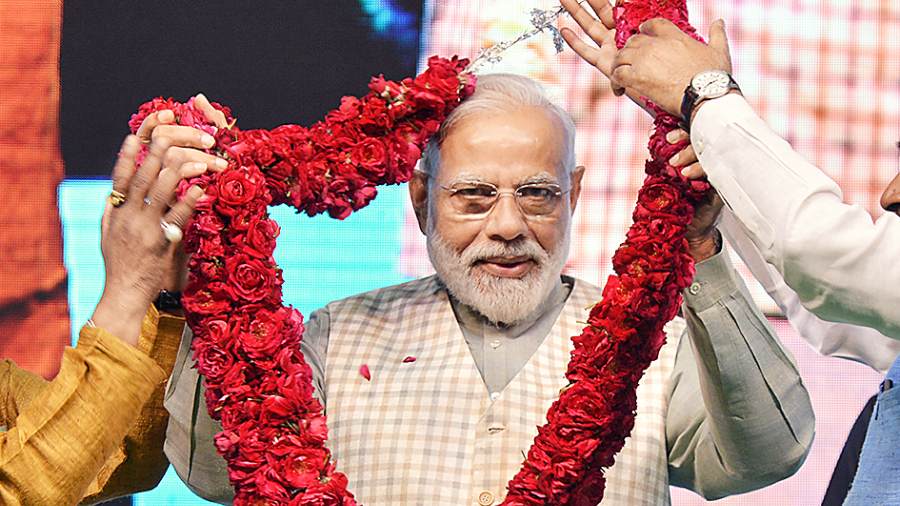Books: The Architect Of The New Bjp: How Narendra Modi Transformed The Party
Author: Ajay Singh
Publisher: Ebury
Price: ₹599
Prime Minister Narendra Modi may not be a universally liked leader but he undoubtedly rouses curiosity for his special skill of climbing so high and so fast to the top. It is no wonder, therefore, that there is now a steady trickle of Modithemed books, The Architect of the New BJP by Ajay Singh being the latest. But caution should prevail if one intends to obtain from the book a holistic idea of what exactly makes the ‘Modi magic’ work. Instead, at every point where Modi’s path seems shrouded in fog, the author either diverts you to some flimflam or simply puts up a ‘road block’ sign. Missing is the “architect” and also the “New BJP”. Instead, it looks like a two-pronged project — to gloss over the blisters on the subject’s track record, there are too many of them, and to fill the gaps in the profile with a strenuous attempt to imagine a host of statesmanly virtues.
It is an acknowledged fact that Narendra Modi hit the international headlines not for any display of his organisational skills or “oratory”, as Singh claims, but for being allegedly associated with the days of infernal violence in February 2002 that rocked Gujarat and left about 2,000 dead, mostly Muslim. Singh is as economical with ink in giving a glimpse of the blood-spattered state under Modi’s charge. Instead, he wallows on how Modi became a Hindu hridaysamrat “stronger than Advani and Bal Thackeray”. He says others were “comparing him to Hitler” in a remarkably placid tone. And, then, Singh’s narrative shifts to Goa where, at the Bharatiya Janata Party’s national executive meeting, the party’s “younger generation, led by Pramod Mahajan and (Arun) Jaitley, gave strong indications to the veterans” that sacking Modi would go against the party’s “ideology”. It didn’t occur to the writer that the happenings in Gujarat can’t possibly be tossed aside as an ideological battle when the world was calling it a pogrom; Western governments, including the United States of America, the United Kingdom and the European Union, had banned Modi’s entry for ten years.
The omissions are not just glaring; they point to a striking determination to clean up a crime scene, leaving no footprints on the grass. There is only a single mention of Haren Pandya, as a BJP state minister, but little reference to his strong views on the criminality of the State in the Gujarat violence, which he expressed before a fact-finding mission led by Justice V.R. Krishna Iyer. Shortly after this, Pandya was assassinated.
Gujarat under Modi soon turned into the last scene of Hamlet with the likes of Sohrabuddin Sheikh, Kauser Bi and Tulsiram Prajapati getting bumped off but after leaving trails of their connections to political leaders. In Modi’s Gujarat, the stench of blood in the corridors of politics was overpowering; so much so that Amit Shah, the then state home minister, was detained in connection with one of the murder cases. There is one unexpected reference to Sohrabuddin — the man who could have been hired to dispatch Pandya — but that is to bring the Congress president, Sonia Gandhi, into the narrative, to suggest the reason for her snarky reference to Modi as “maut ka saudagar”. It was a “blunder” by Gandhi as, according to Singh, Modi had by then become so sacred a personage that harsh words against him would translate into votes for him and against the speaker. Modi, on his part, was hardly lacking in his collection of politically insensitive fusillade. As Singh informs, Modi’s colourful term, “Sultanat”, about the Gandhi family, and the code, “begum”, for Sonia, were all minted during the 2007 Gujarat poll.
Singh is currently serving as press secretary to the president of India, so it is not unexpected to feel the presence of ‘handlers’ in crafting the book. That shows not only in the omissions —nobody expects a government book on Modi to be explicit about, say, the rise of cow vigilantes and the lynching of Muslims — but also in the careful choice of some tall figures of the saffron brotherhood, notably L.K. Advani, to ‘Other’ them. Advani, Singh argues, was not quite the unquestioned hero of Hindu nationalism that he is portrayed as. In fact, Advani became a suspect in the eye of the sangh parivar for doing too many things “unilaterally” or on the sly. It is hinted that after the Vajpayee government’s fall, Advani needed a big post for himself so he pipped M. Venkaiah Naidu, the then party president, to the post. The saffron brotherhood didn’t like the idea of the leader of the Opposition grabbing the party chief’s post too. The final fall came with Advani’s pro-Jinnah speech in Karachi which, Singh testifies, was not prompted by Sudheendra Kulkarni, the writer in attendance, but was Advani’s own brainwave. Ironically, in the 2002 meeting after the Gujarat bloodbath, it was Advani’s support, rather than the juniors’ advocacy, that had tipped the scale in favour of retaining Modi in power.
If Singh’s book is a project to present Modi’s way of looking at his own life, it is a truthful presentation of a self marked by secrecy and selfishness.










